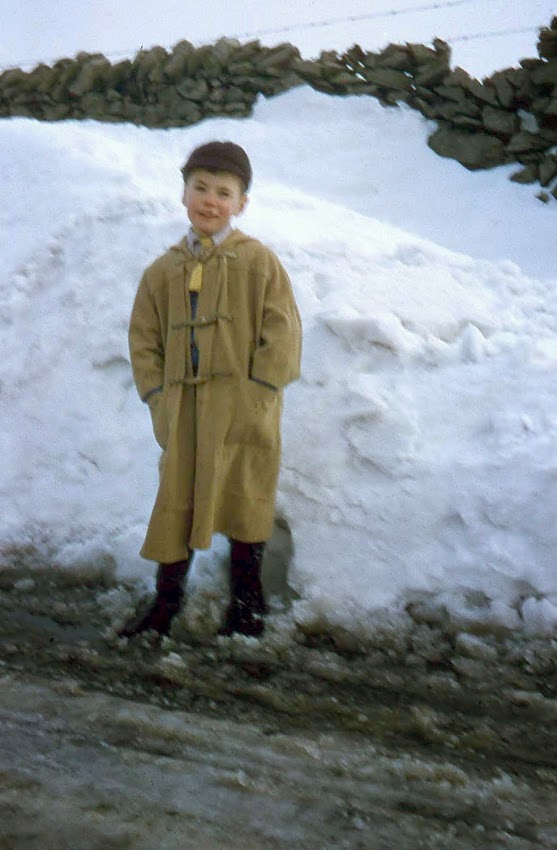Fri. 30 March: Kananaskis Day Trip
It might surprise some Calgarians, but as the crow flies, it’s only about 50 miles from our front door to the edge of the Upper Kananaskis Lake
Wanting to see how much snow there was in the mountains, I set out on a day trip to the bottom end of the Kananaskis Valley
The sun was just catching the top of Mt. Kidd Chester Lake
I soon caught up with the massive snow-plough, which was clearing a good foot of snow off my side of the road. At the turn-off to the Chester Lake Chester Lake
I had to drive back down the highway on the wrong side of the road as my side hadn’t been ploughed yet. Luckily I only came across one slow moving vehicle coming my way, so I returned safely to the Kananaskis Valley
The Canyon parking area was also piled high with snow, but luckily another plough had just been in there a minute before I arrived, so I parked below a drift and headed out on my snow shoes to explore the Penstock Trail.
This pretty trail skirts the bottom edge of the Lower Kananaskis Lake Kent Creek
The trail then headed into the woods, crossed back over the road, and meandered through deep forests, finally returning to the lake. This was an ideal snow shoe trip for leisurely travelers such as myself.
Not being totally idle, I decided that I would also like to check up on the cross-country skiing conditions although it was already a few degrees above freezing – ideal for waxless skis. First, however, I stopped at the Kananaskis visitor centre which was open, and the busy lady was directing a few first-time visitors to the best trails. I always enjoy relaxing on the comfy couches in front of the huge windows looking out to the Opal Range
At the cosy Pocaterra Hut, there was nobody inside, and only a couple of people returning from a short trip on the trails. I met a couple of other small parties of two or three and soon found myself breaking trail on what is perhaps the most popular cross-country ski trail in Kananaskis Country. There had been three or four inches of new snow last night and my waxless skis gripped the snow well. Soon I was at the Lynx Trail junction and relaxing under a warm sunshine at the handily placed picnic table. Nobody had been this way today. It was a peaceful scene, although there was a wind in the trees, and high up in the mountains above me, the snow was swirling around.
On my return journey I took Stroil and Come Along trails for my first time ever, and found the moderate and “most difficult” sections easily manageable. But the bent “most difficult” sign suggested a few dramas in past times. I came across no other skiers on the trail. The thermometer on the outside wall of Pocaterra Hut told me it was plus 8 C and a puddle below it suggested that this might be the beginning of the end of this year’s skiing season here - although it will take months before all this snow melts.
Still curious about the snow depth closer to the Great Divide, I drove along to the end of the road at the Upper Kananaskis Lake Upper Lake
By now my curiosity had been satisfied- there was LOTS of snow here! On my way back up the Valley, I stopped in at the Kananaskis Village
To make a change I turned west on the Trans-Canada Highway and returned to the city along Highway 1A. I had not travelled this road for decades and was surprised how narrow and twisting it was. Here there was no snow. At one stage the road runs alongside the wide Bow River Kananaskis Valley
Statistics | |
Penstock Snowshoe Trail | |
Fri. 30 March | |
Total Dist. | 4.8 km (‘shoe) |
Height Gain | 100ft. |
Max. Elev. | 5,600 ft. |
Time | 2 hrs. 1 min. |
Statistics | |
Pocaterra Ski Trail | |
Fri. 30 March | |
Total Dist. | 7.5 km (XC ski) |
Height Gain | 260ft. |
Max. Elev. | 5,545 ft. |
Time | 1 hr. 50 mins. |
Other Stats. | |
Start ‘shoe: 9.16 am Creek: 10.02 am Ret. to car: 11.17 am Temp: +3 to +5 C Few flurries, o’cast | Start ski: 11.57 am Jn Lynx: 12.48 pm Ret. to hut: 1.47 pm Temp: +7 to +8 C Sunny breaks |


















